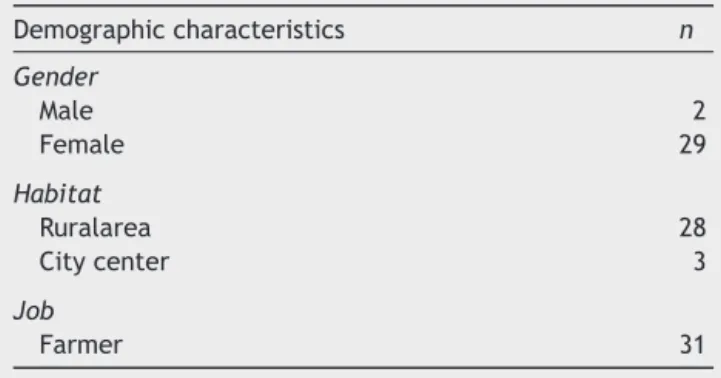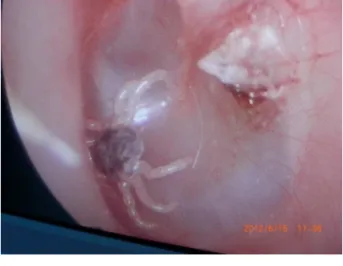www.bjorl.org
Brazilian
Journal
of
OTORHINOLARYNGOLOGY
ORIGINAL
ARTICLE
Otoacariasis:
demographic
and
clinical
outcomes
of
patients
with
ticks
in
the
ear
canal
夽
Ozan
Gökdo˘
gan
a,∗,
Taliye
C
¸akabay
b,
Hacer
Baran
c,
Burak
Karabulut
d,
Cihan
Tasdemir
e,
Zati
Vatansever
faClinicofEarNoseThroat,MemorialHospital,Ankara,Turkey
bClinicofEarNoseThroat,KanuniSultanSuleymanResearchandTeachingHospital,Istanbul,Turkey cClinicofEarNoseThroat,MedicalParkHospital,Bursa,Turkey
dClinicofEarNoseThroat,UmraniyeResearchandTeachingHospital,Istanbul,Turkey eDepartmentofMicrobiology,ArdahanStateHospital,Ardahan,Turkey
fKafkasUniversity,VeterinaryDepartment,Kars,Turkey
Received1March2015;accepted13July2015 Availableonline6November2015
KEYWORDS
Otoacariasis; Thick;
Otobius
Abstract
Introduction:Otoacariasis,theattachmentofticksandmiteswithintheearcanalisacommon phenomenonespeciallyinruralareas.
Objective:Todeterminetheclinicalanddemographicfeaturesofcaseswithdetectedticksin theearcanal,whichisacommonhealthproblem,andidentifytickspecies.
Methods:Dataofpatientswhohadotoacariasiswerecollected.Wealsoinvestigatedallticks attheVeterinaryDepartmentofKafkasUniversity.
Results:Wepresentthedataofpatientswithotoacariasis.Alltickswereidentifiedasotobius. Otobiustickswerefoundnotrelatedwithanycomplications.
Conclusion:Itisveryimportanttodetectticksintheearcanalastheyactasvectorofsome diseases.Identifyingspeciesofticksmayhelpclinicianstopreventfurthercomplications asso-ciatedwithvector-bornediseases.
© 2015 Associac¸˜ao Brasileira de Otorrinolaringologia e Cirurgia C´ervico-Facial. Published by Elsevier Editora Ltda. This is an open access article under the CC BY license (http:// creativecommons.org/licenses/by/4.0/).
夽
Pleasecitethisarticleas:Gökdo˘ganO, C¸akabayT,BaranH,KarabulutB,TasdemirC,VatanseverZ.Otoacariasis: demographicand clinicaloutcomesofpatientswithticksintheearcanal.BrazJOtorhinolaryngol.2016;82:416---21.
∗Correspondingauthor.
E-mail:ozangokdogan@gmail.com(O.Gökdo˘gan). http://dx.doi.org/10.1016/j.bjorl.2015.07.018
PALAVRAS-CHAVE
Otoacaríase; Carrapato;
Otobius
Otoacaríase:desfechosdemográficoseclínicosdepacientescomcarrapatosno
condutoauditivoexterno
Resumo
Introduc¸ão: Aotoacaríase,fixac¸ãodecarrapatosdurosemolesnointeriordocondutoauditivo, éfenômenocomum,especialmenteemáreasrurais.
Objetivo: Determinarascaracterísticasclínicasedemográficasdecasosdecarrapatos detec-tadosnocondutoauditivoexterno,umproblemadesaúdefrequente,eidentificarasespécies doácaro.
Método: Coletaram-sedadosdospacientescomotoacaríase,etodososcarrapatosforam inves-tigadosnoDepartamentodeVeterináriadaUniversidadeKafkas.
Resultados: Os dadosde pacientes comotoacaríase são apresentados. Todosos carrapatos foramidentificadoscomopertencentes aogêneroOtobiuseconstatou-se nãohaverrelac¸ão entreoscarrapatosequalquertipodecomplicac¸ão.
Conclusão:Émuito importantedetectar carrapatosnocondutoauditivoexterno,poisesses ácarosfuncionam como vetorespara algumas doenc¸as. A identificac¸ãodaespécie doácaro pode ajudar oclínico aprevenir complicac¸ões associadas àsdoenc¸as transmitidas poresse vetor.
© 2015 Associac¸˜ao Brasileira de Otorrinolaringologia e Cirurgia C´ervico-Facial. Publicado por Elsevier Editora Ltda. Este ´e um artigo Open Access sob uma licenc¸a CC BY (http:// creativecommons.org/licenses/by/4.0/).
Introduction
Otoacariasis,theattachmentofticksandmiteswithinthe earcanal,isacommonphenomenoninlivestockand domes-ticanimals,wheretheearsareacommonsiteofattachment ofmites,suchasPsoroptesandOtodectes,andticks,suchas Otobiusmegnini andseveralRhipicephalusandHyalomma spp.1---3
TickshaveexistedforthousandsofyearsonEarth.There havebeenticksintheenvironmentwherehumansand ani-malshaveexisted.Thereareover900differenttickspecies throughouttheworld,andapproximately46ofthesespecies havebeenfoundtobeactiveinTurkey.Ticksactasa vec-torofinfectionofviral,bacterial,rickettsialandparasitic infections,spreadingthroughboth mechanicaland biolog-ical pathways. Therefore, they are accepted as a public healthproblemallovertheworld.4,5
Approximately 80% oftheworld’s tickfaunaareixodid ticks(hardticks)andtherestareargasidticks(softticks)out ofover900currentlyknowntickspecies.Theworld’sargasid tickfaunaisdividedintofourgenera,includingArgas, Car-ios,OrnithodorosandOtobius.6
Mosttickshaveapreferenceforfeedingoncertaingroups of wild animals, with some even being quite host spe-cific,whereasthenumberofspeciespertinenttodomestic animalsand/orhumansislimited.Fewspeciesadaptto live-stock or feed ona human subject, and theydevelop into efficientvectorsofarangeofpathogenicmicroorganisms. Allhumantick-bornediseasesarezoonoses.7
Mostpeoplebecomeinfectedinspringandsummer,and especiallybytickbites.However,therearevariousdiseases causedbyticks;someofthemneedspecialinterest.Rocky Mountainfever,tularemia,LymediseaseandCrimean-congo hemorrhagicfever(CCHF)need moreattentionbecauseof theirhigherincidence,morbidityandevenmortality.
CCHF is one of the most important tick-borne viral diseases of humans, causing sporadic cases or outbreaks ofsevereillnessacrossahugegeographicarea.Hyalomma ticks are the principal source of human infections. NairovirusinthefamilyBunyaviridaeistheetiologicfactor of CCHF. Tularemeia is a multi-systemic disease caused by the bacterial pathogen Francisella tularensis. Biting flies, water exposure, food and aerosols as well as ticks cantransmitthe disease.F. tularensis ishighly infectious andclinical infectionmay beseen after exposuretovery few amounts of bacteria. Lyme disease is caused by the spirocheteBorreliaburgdorferi.ThemainvectorsforLyme disease are ticks. Mouse and small mammals are natural reservoirsforB.burgdorferi.RockyMountainspottedfever iscausedbyRickettsiarickettsii.Ticksarethemainvector andthediseaseismorecommonfromApriltoSeptember.
Themaincomplicationsofintra-auralforeignbodiesare canalabrasion,lacerationor bleeding, but thesecanalso causeotitis externa,perforate or rupture the tympanum, suppurativeotitismedia,affectingthe middleear.8Inour
clinicalpractice,casesofhumanotoacariasiswerea com-monoccurrenceatanear,noseandthroat(ENT)wardover alongperiod,andthispromptedaprospectiveetiological andepidemiologicalstudy,theresultsofwhicharereported herein.Theaimofthisarticleistoreportdemographicand clinicalcharacteristicsofthecasesofticksintheearcanal thatwehavedeterminedalmostincontrastwithliterature aswellasreviewsintheliterature.
Method
Ethicalconsiderations
Table1 Demographiccharacteristicsofpatientswithtick inearcanal.
Demographiccharacteristics n
Gender
Male 2
Female 29
Habitat
Ruralarea 28
Citycenter 3
Job
Farmer 31
approvedtheadmissionon27September2012withdecision number16(Supplement1).
The patientswhowere diagnosedwithticks inthe ear canal in the emergency department and otorhinolaryngo-logydepartmentofourStateHospitalbetweenJanuaryand December 2012 have been included the study. Our state (landarea5576km2;population105,000;elevation1900m;
mean annual rainfall 500mm; mean annual temperature 13◦C;meanrelativehumidity73%) islocatedin northeast ofourcountry.Themaineconomicactivitiesinthedistrict areagricultureandlivestock.
Patients’age,gender,occupation,theregionwherethey livein,applicationtime,complaints,physicalexamination findings,resultsofconsultationwiththeinfectiousdisease department and follow-up (at least ten days) have been recorded.
The cases were treated withthe same intervention of removingthetickswithalligatorforceps.Theprocedurewas carriedout with otoendoscopy or otomicroscopy to avoid anyharmfuleffectstoearcanal.Otoendoscopicand micro-scopicevaluationwasmadetochecktympanicmembrane andouter earcanalin everypatientafter theremovalof theticks.
The ticks removed from the external ear canal of the patientswerepreservedinalcoholandstoredinseparate, labeledvials.Infectiousdiseaseconsultationwasmadefor every patient. We could not make any tests for possible infectiousdiseasesbecauseofinsufficientconditionsinour hospital.Tickswerekeptforinvestigationintermsof pos-sibletestsforcontagiousdiseases.
Ticks were identified using standard keys and descrip-tions. Reference collections from a larger study on tick ecology that included voucher specimens of the species identifiedhereinaredepositedattheInstituteofVeterinary ofourstate university.Ofatotalof31samplescollected, allhadaccompanyingpatientdetailssuchasage,sexand the other domestic livestock present in their households. Theanalysisoftickspecieswascarriedoutfortheentire31 cases.
Table3 Thecomplaintsofadministrationofpatient’swith tickinearcanal.
Otalgia 27
Eardischarge 3
Hearingloss 26
Fullnessinear 28
Tinnitus 17
Results
There were 29 female and 2 male patients. Ages of the patientsvaryfrom17yearsofageto72yearsofagewith anaverageof32.28yearsofage.Thesourceofincomeof allpatients wasagriculture andlivestock,and28of them lived inthe ruralarea,whereas3lived inthe city center (Table1).
Thetimeoftheapplicationswasalsoanalyzedand pre-sented in Table2. There wasasignificant increase in the peakduringSeptember/May.
The complaints of the administration have been illus-tratedinTable3.
Inthephysicalexamination,thetickswerefoundon17 patients’ right ear and on14 patients’ leftear out of 31 patients. Tickswereremoved fromthe outerearcanal of 27patients,3tickswereremovedfromthetympanic mem-braneandonewasremovedfromthemiddleearofapatient whohad chronicotitis mediaconcurrently.In onepatient twoticks wereremoved at thesame time.Alsotwoticks were removedfrom differentearsof the samepatientat differenttimes.
Outerearcanal edemaandhyperemiawereseen inall patients. Removal of ticks was carried out with alligator forceps, using local anesthesia. Otoendoscopy or otomi-croscopywasusedinallcases andcontrol wasmadewith microscopicevaluation.
No complication such asouter ear canal laceration or tympanicmembraneinjuryonthepatients whohadouter earcanaltickshasbeendetermined.Therewerehyperemia and milimetric to small tympanic membrane perforation in 3 patients fromwhom the removal fromthe tympanic membranewasmade.Onepatienthadpermanenttympanic membraneperforationwhereastwoofthepatients’ perfo-rationwasclosedspontaneously. Nocomplicationresulting frompatienthavingthetickremovedfrommiddleearwas observed.
Infectiousdiseaseconsultationwasmadeinallcasesin ordertoavoiddiseaseshostedbyticks.Patientswere con-trolledespeciallyforcrimean-congohemorrhagicfeverand tularemia.Nosign, symptomandfindingof thesediseases wereobserved,althoughtularemiaisnotrareintheregion. Even crimean-congo hemorrhagic fever wasnot observed
Table2 Thetimeofapplicationofpatient’swithtickinearcanal.
January February March April May June July August September October November December
Figure1 Tickoneardrum.
Figure2 Tickremovalwithalligatorforcepsunder endomi-crscopicevaluation.
in our town in any patients, who were checked for both diseases.
Patientswerealsocontrolledinourambulatoryservice on the second and the tenth day. Except for one perma-nentperforation,noothercomplicationwasobservedinthe followupofthepatients.
AlltickswereanalyzedbytheVeterinaryDepartmentof our regional University. All of the ticks were reported as Otobiusspecies(Figs.1---4).
Discussion
Ticks and tick-borne diseases both affect animals and humansandhave asignificant cost.Approximately 10%of over 900 known tick species act as a vector of different pathogensofanimalsandhumans,besidesbeingresponsible fordirectdamageduetotheirfeedingbehavior.4
Typeanalysiswasn’tmadeatthetimeofthe administra-tion.Theticksremovedfromtheexternalearcanalofthe patientswerepreservedinalcohol,andstoredinseparate, labeledvials.Tickswerecollectedforbothpossiblediseases thatcandevelopwithtimeandfortheanalysisofpossible hostingdiseases.Outofatotalof31samplescollected,all hadaccompanyingpatientdetailssuchasage,sexandthe
Figure3 Removedtickfromear.
Figure4 Earlypostoperativeimagesofmultipleperforations aftertickremoval.
otherdomestic livestock presentin theirhouseholds. Ref-erencecollectionsfromalargerstudyontickecologythat includedvoucherspecimensofthespeciesidentifiedherein aredepositedattheInstituteofVeterinaryinourstate uni-versity.Theanalysisoftickspecieswascarriedoutforthe entire31casesandidentifiedasOtobiusMegnini.
O.Megninihasasingle-hostlifecycleconsistingoflarval stages followed by a variable number of nymphal stages. Theparasiticphasemayexceed200days.Thelastnymphal stagedropstothe soiltotransformintothenon-parasitic adultstage.FertilizedfemaleO.Megninilayseveralbatches ofeggs.
notfeed. Heavy infestations of thesepicks may occur on horses,cattle,sheepanddogs.
Withoutactingasvectorsofdisease,tickscanbeharmful tolivestockandareof greateconomic importancesimply becauseoftheirdirecteffects.O.Megninicancauseotitis inhumans,mayplayaroleinthemaintenanceoftheagent ofQfeverinnatureandmaybeassociatedwithparalysisin children.9,10
Avarietyofmicroorganismsincludingprotozoa, rickett-siae, spirochaetes and viruses can be transmitted from animalstohumansthroughticks.Moreover,tickscancause severe toxic conditions such as paralysis and toxicosis, irritationandallergy.7
Tick-bornediseasesarestillrankedhighintermsoftheir impactonthelivelihoodofresourceofpoorfarming commu-nitiesindevelopingcountries.Globaleconomicimportance ofticksisparticularlyhighforlivestock.
Transfer of a disease starts with the feeding of a tick onaninfectiousvertebrate host.Duringfeedingtheytake thepathogenthroughblood meal.Theytransferpathogen toanotherhostwhenfeedingagain.11 Theycanalsoresult
inparalysis,toxicosis,severelocalreactionssuchasforms ofpruritus,secondarybacterialinfectionsandavarietyof reactionscausedbyimmune-mediatedresponses.12
Tick bites are commonly seen in the head and neck region,in the lower extremity and in the arms. Occupa-tiongroupsandagedistributionarereportedinaverywide range.Therewerereportsofdifferentwaysofcomingacross withticks,suchasduringagricultureandlivestockactivities asinourcasesandalsoduringpicnicsintheenvironmentor closecontactwithanimals,likepeopleworkinginbutcheries orworkingasveterinaries.
TherewasadearpeakduringMay/September,whenthe animalswerefeedingoutsideduringbetterairconditionsin theregion,asAugustisthemonthwiththehighestnumber ofcases,relativetomuchmoreexposure.Itwasreported thattheticks areincreasinginhotseasons andalso com-plaintsusuallyaremadebetweenJuneandSeptember,when theriskofexposureisveryhigh.13,14
Patient with exposure history and symptoms including fever, malasia and other nonspecific symptoms, together withphysicalfindingssuggestiveofvascularleakand coag-ulation defect must be evaluated for CCHF. Leukopenia, thrombocytopeniaandelevatedserumliverenzymesmaybe seeninlaboratoryevaluation.Certaindiagnosisismadeby showingviralnucleotideandviralanticores.Deathsrelated especiallywithCCHFhaveincreasinglybeenreportedinthe lastfewyears.Differenttreatmentoptionsincludinggeneral supportive measures, antiviral therapy, antibody therapy andvaccinesareusedinCCHF.15
Differentformsoftularemia, includingulceroglanduler, oculoglandular, pneumonic, oropharyngeal, gastrointesti-nal,andthphoidalformsmaybeseen inclinical practice. The most common type is ulceroglanduler form, char-acterized by chills, fever, head and muscle pain and prostration,usually3---6daysafterexposure.Prompt antibi-otictreatment, such asfluoroquinolones,aminoglycosides and supportive therapy, generally has good results, with favorableprognosis.Also,differentvaccinesfor tularemia havebeendeveloped.16
FirststageofLymediseaseisseen7---10daysafter expo-sure.Atypicalrashcallederytemamigransoccursattheside
ofthetickbite.Also,fever,fatigue,arthralgias,headaches, cough and lymphandenopathy may be seen. In stage 2 of Lymedisease,alsocalled earlydisseminatedstage, multi-plesecondarycutaneousannularlesions,fever,adenopathy andcentralnervoussystem symptomsmayoccur. Instage 3,latechronicdisease,symptomsincludechronicarthritis, centralnervoussystemproblems,dermatitisandkeratitis. Laboratorytests,includingELISAtests,helpthediagnosisof Lymedisease.Inmostcasesantibiotictreatment,including doxycyclineoramoxicillin,iscurative.17
First symptoms usually occur 5---7 days after exposure in Rocky Mountain spotted fever. Malaise, myalgia, fever headaches, nausea and vomiting are common symptoms. With non-specific symptoms,an exanthemappears within thefirstfewdaysofsymptoms.Theskinlesionsmaychange andcoalescetoformlarge areasofecchymosisand ulcer-ation.Respiratory,circulatoryandneurologiccomplications may occur. Patientswith glucose-6-phosphate dehydroge-nasedeficiencyareathighriskforcomplications.Diagnosis ofRockyMountainspottedfeverisbasedonclinicalsignsand symptoms.Laboratorytests,especiallyimmunofluorescent stainingforrickettsia,helpthediagnosisofRockyMountain spotted fever. Tetracycline, doxycycline, chloramphenicol and fluoroquinolones are used in the treatment of Rocky Mountainspottedfever.Promptantibiotictreatmenthelps goodprognosis.18
Infectious disease consultation was made in every patient,andnodiseasesrelatedwithtickswereobservedin thecases.Thiswasattributedtothepresenceofdifferent typesofticks.Hostingandcontaminatingpropertieschange withthe typeofticks. Geographicregions alsoaffect the typeofticks.19,20
Althoughmanyofthepatientsreportedwithforeign bod-iesintheearcanalareunder8yearsold,inthereportthat wepresenttheyoungestcase whereticksintheouterear werefoundwasa17year-oldindividual.In otorhinolaryn-gologypractice,childpatientscomprisemanyofthecases offoreignbodiesintheearcanalorthenasalcavity; how-ever,inadults,foreignbodiesintheearareusuallycaused bytraumaoraccidents.
Themainsymptomofforeignbodiesintheearcanalis pain.Sometimesthereisnosymptomrelatedwithforeign bodies.Families canrarely see or suspect foreignbodies, whichmaybetheadministrationsymptom.21 Weobserved
inourcasessymptomssuchasfullnessinear,hearingloss, pain,dischargeintheearandtinnitus.Inthesecases,we also observed that the pain usually starts approximately 3 or 4 days after fullness and hearing loss starts; there-fore, administrationtoour departmentis made generally 3or4daysaftertheentranceofticks.Whenweanalyzedthe complaintsindetail,wesawthatthepatientsusuallyseek further examination when pain accompanies other symp-toms. We also demonstratedthat hearing loss in patients wascausedbytheobstructingmasseffectofticks.
Itwasreportedthatremovalofforeignbodiesdonewith generalanesthesiainsome cases.22 Thisnecessity maybe
duetodissonanceofchildrentoexaminationsor interven-tions.Inourcasesallofthepatientswereadultsandnone ofthemneededgeneralanesthesia.
aspossible bypulling outthe head ofticks withthehelp ofalligatorforceps,inordertoextractthetickaliveinthe casesofticksintheearcanal.
Theimpactoftickfeedingandtick-transmitteddiseases andtheircontrolshouldbemuchbetterdefinedineconomic terms.Tickcontrolonlivestockremains,toalargeextent, basedonacaricides,buttheiruse inpossiblecombination withanti-tickvaccinesandutilizationofhostresistanceto ticks shouldreduce dependency onchemical tickcontrol. Researchintonovel,ecologicallysound,practicaltick con-trolmethodsshouldbeintensified,andimplementationof existingmethodstovaccinateagainsttick-bornediseasesis recommended,aswellasintensifiedresearchtoward devel-opingnovel vaccines anddelivery systems.Muchprogress isexpectedinthenextfewyearsthroughtheuseoftools availableinthepost-genomicera.Itcanalsobeexpected thatnewtick-bornepathogens willcontinue tobe discov-ered.Furthermore,inthefuture,wemaybeabletoexploit for medicalpurposessomeof theconsiderable numberof bioactivemolecules ofthefascinating,largelyundisclosed tickpharmacy.
These cases areof interest in that O. Megnini infesta-tions seem to producelittle annoyance tohumans during theextendedlarvalandnymphaldevelopmentalperiods.In allthe cases,theticks hadmoltedintonymphsand were completelyengorgedwhenremoved.
It is evident that human parasitism by this tick is a potential health problem in rural areas of our country, wherepeopleliveinclosecontactwithdomestic animals. O. Megniniinfestations could resultin eardamage or the transmissionofinfectiousdiseaseagents.
Conclusion
In conclusion, it has to be kept in mind that ticks in cases withforeignbodiesin the earcanal areseen espe-ciallyinruralareas.Incontrastwithotherforeignbodies, theycanresultinsystemicsymptomsandproblems. There-fore, patients must be evaluated systematically, even in consultations with the related departments. Hosting and contaminating are very important for both the patients’ prognosis andthe physicians’ health. After coming across withpatientswithticksontheirbodies,toinformthecases to related units to receive the necessary education and interferencesisimportantforpublichealth.
Conflicts
of
interest
Theauthorsdeclarenoconflictsofinterest.
References
1.NaudeTW,HeyneH,vanderMerweIR,BenicMJ.Spinoseear tick,Otobius megnini(Duges,1884) asthecause ofan inci-dent ofpainful otitisexterna in humans.J SAfr VetAssoc. 2001;72:118---9.
2.DilrukshiPR,YasawardeneAD,AmerasinqhePH,Amerasinqhe FP.Humanotocariasis:aretrospectivestudyfromanareaofSri Lanka.TransRSocTropMedHyg.2004;98:489---95.
3.Al-ArafAM,MullenGR,RashadR,Abdel-HamedA,OconnorBM, AlkhalifeIS,etal.Ahumancaseofotoacariasisinvolvinga his-tiostomatidmite(Acari:Histiostomatidae).AmJTropMedHyg. 2007;76:967---71.
4.Wikel S. Ticks and tick-borne pathogens at the cutaneous interface: host defenses, tick countermeasures, and a suit-ableenvironmentforpathogenestablishment.FrontMicrobiol. 2013;19:337.
5.BursaliA,KeskinA,TekinS.Areviewoftheticks(Acari:Iwodida) ofTurkey:speciesdiversity,hostsandgeographicaldistribution. ExpApplAcarol.2012;57:91---104.
6.HorakIG,CamicasJL,KeiransJE.TheArgasidae,Ixodidaeand Nuttalliellidae(Acari:Ixodida)aworldlistofvalidticknames. ExpApplAcarol.2002;28:27---54.
7.JongejanF,UilenbergG.Theglobalimportanceofticks. Para-sitology.2004;129:3---14.
8.Al-JubooriAN.Auralforeignbodies:descriptive studyof224 patientsinAl-Fallujahgeneralhospital,Iraq.IntJOtolaryngol. 2013;2013:401289.
9.LaseckaL, BaronMD. Themolecular biology ofnairoviruses, an emerging group of tick-borne arboviruses. Arch Virol. 2014;159:1249---65.
10.Yilmaz GR, BuzganT, Irmak H,Safran A, Uzun R, CevikMA, etal.TheepidemiologyofCrimean-Congo hemorrhagicfever inTurkey,2002---2007.IntJInfectDis.2009;13:380---6. 11.NavaS,MangoldJ,GuglielmoneAA.Fieldandlabarotory
stud-iesinaNeotropicalpopulationofthespinoseeartick,Otobius megnini.MedVetEntomol.2009;23:1---5.
12.MastropaoloM,NavaS,GuglielmoneAA,MangoldAJ. Develop-mentalchangesinsalivaryglandsofnymphsandadultsofthe spinoseeartickOtobiusmegnini.JParasitol.2011;97:535---7. 13.Fingerle V, Rauser S, Hammer B, Kahl O, Heimerl C,
Schulte-Spechtel U, et al. Dynamics of dissemination and outersurfaceproteinexpressionofdifferentEuropean Borre-liaburgdorferisensulatostrainsinartificiallyinfectedIxodes ricinusnymphs.JClinMicrobiol.2002;40:1456---63.
14.PecinaCA.Tickparalysis.SeminNeurol.2012;32:531---2. 15.HeimSW, MaughanKL. Foreign bodiesinthe ear,nose, and
throat.AmFamPhysician.2007;76:1185---9.
16.BalbaniAP,SanchezTG,ButuganO,KiiMA,AngélicoFVJr,Ikino CM,etal.Earandnoseforeignbodyremovalinchildren.IntJ PediatrOtorhinolaryngol.1998;46:37---42.
17.BenteDA,ForresterNL,WattsDM,McAuleyAJ,WhitehouseCA, BrayM. Crimean-Congohemorrhagic fever: history, epidemi-ology, pathogenesis,clinical syndrome and geneticdiversity. AntivirRes.2013;100:159---89.
18.FoleyJE,NietoNC.Tularemia.VetMicrobiol.2010;140:332---8. 19.BrattonRL,CoreyGR.Tick-bornedisease.AmFamPhysician.
2005;71:2323---30.
20.Dantas-Torres.RockyMountainspottedfever.LancetInfectDis. 2007;7:724---32.
21.ErenlerAK,KulaksizF,UlgerH,ErdemM,Koc¸ak C,Söylemez F,etal.Characteristicsofpatientsadmittedtotheemergency departmentduetotickbite.TropDoct.2014;44:86---8. 22.Basol N, Duygu F, Ayan M. Detailed evaluation of patients
admittedtoemergencydepartmentwithatickbitecomplaint. Medicina(Kaunas).2013;49:367---71.

